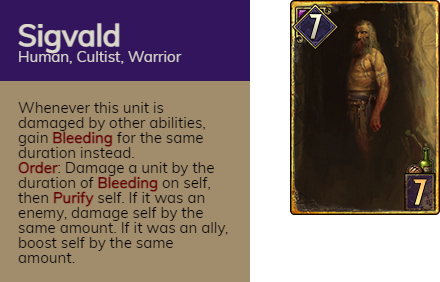Introduction
I was about to write Gwent 10.2 Patch Notes review today, but looking into a certain card rework i’ve written too much to finish the article on time. So here we are – Sigvald analysis instead.
The Card

Description and Evaluation
Sigvald is a damage target unit in the self-wound archetype. This card ability is very complex and needs to be analysed step by step.
Other than intrinsic bleeding, Sigvald could not be damaged by own and enemy cards. Only seize, locks and hard removal could counter Sigvald. He is irremovable for damage reliant decks. Sigvald will always play for optimal value in a long round in such case.
Bleeding leads to 1 damage at the end of your turn and never could exceed 9 damage in total, given that Sigvald is played first and starts to be damaged from the 2nd turn.
Order ability effectively grants 1 point for every bleeding stacked on Sigvald. Unlike Turiseach Veteran, it is uncapped added value rather than just neutralisation of self damage.
Sigvald And Self-Wound Engines
Let’s roughly estimate Sigvald power when placed between two +1 per turn self wound engines. Let’s assume sequence: Sigvald -> 1st engine -> 2nd engine.
Then turn by turn we have:
7 power / 0 bleed
7 power / 1 bleed (after Priest left; bleed doesn’t trigger here!)
6 power / 2 bleed (after Melusine right)
5/3
4/4
3/5
2/6
1/7
8 turns total. And here Sigvald order has to be used or he dies. Offensive ability would be worth 6 points if only target with enough power is available.
For the sake of comparison, let’s imagine replacing Sigvald with a 7 power Elder Bear:
7 power
6
4
2
0
-2
-4
-6
In the same amount of time our imaginary Elder Bear reached -6 power. To estimate the strength of Sigvald effect, let’s compare numbers. The net difference is equal to ~12 points which means that Sigvald effectively played as 19 for 7 after 8 turns. It could be roughly said, that Sigvald is +2 per turn engine when all setup is completed.
Combos and Synergies with Sigvald
Self-wound engines fodder value is just one of Sigvald functions. Let’s have a look at combinations with other cards.
– Drummond Villager could play straight up as 12 for 4 with Sigvald on the board. Also note that this unit could be played from Fucusya/Harald an Craite, possibly as 24 for 14/18+ for 12 value. Not to mention bronze graveyard calls like War of Clans and Freya’s Blessing.
– Svalblod Butcher – 10 for 4, same application and possiblities as Villager. Both cards get 8 for 4 value even if Sigvald gets answered somehow.
– Trial of the Grasses and Mardreome – Sigvald is capable of turning both positive and negative effects of these cards into value. Trial could play as 11+6 = 17 for 6 provision on a 1 point Sigvald.
– Harald Houndsnout – Harald provides both great targets for defensive order ability (Skulls) and could play as +1 per turn engine on Sigvald with self-wound ability.
– Knut The Callous – Knut dealing bleeding instead of damage means simply offensive value without any hacks. Knut perhaps should not be played early, but same turn as Sigvald’s defensive order. If Knut damage would be equal to let’s say 7, then 15 for 8 on deploy could be achieved, with a possiblity of +7 per turn if berserk effect could go through.
–Cerys: Fearless – a backbone of every self-wound deck could easily double points gained via healing by damaging Sigvald.
– Artis – Sigvald would get bleed rather than damage, which still doesn’t mean you should play Artis. Nevertheless, Tuirseach Axemen also got buffed…
Summary
Sigvald seems like a timid self-wound engine at the first sight, but old vildkaarl hides great power.
Great props to the designer of this rework, which may almost single-handedly revive Self-Wound archetype. Hope you would have a fruitful visit in the deckbuilder after this read!

